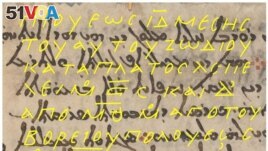30 October 2022
Researchers say they have discovered part of the oldest known map of the stars in an ancient document.
The document was first found in a Christian center, called a monastery, in Egypt. It was made of a material created from animal skin, called parchment, that was commonly used for keeping records in ancient times.
The document contained Christian writings. But scientists who examined the parchment discovered additional writings that appeared underneath on the same parchment. It was common practice at the time to keep using the same parchment to create new writings because the paper could be in short supply.

Yellow outlines show what researchers believe is part of ancient Greek astronomer Hipparchus' long-lost star map. The researchers used a method called multispectral imaging to take pictures of the parchment. (Image Courtesy: Museum of the Bible Collection)
The researchers who examined the parchment found writings related to astronomy. They identified the writings as being created by an ancient Greek astronomer named Hipparchus.
Hipparchus was also a mathematician and is widely considered the creator of the form of math known as trigonometry. But he is also famous for creating what is believed to be the first map of the stars more than 2,000 years ago. Researchers estimate his observations of the sky were mapped around 129 BC.
Historians knew about Hipparchus' map because it was described by other astronomers in later writings. But his own star descriptions were thought to be long lost. The discovery of what is believed to be part of his long-sought star map was recently reported in a study in the Journal for the History of Astronomy.
The researchers used a method called multispectral imaging to take pictures of the parchment. The method uses several cameras to take pictures in different colors. Then, the pictures are combined with X-ray and infrared images. In this case, the process was used to uncover past writings and additional details in the parchment.
The examined document is known as the Codex Climaci Rescriptus. It is currently part of a collection held by The Museum of the Bible in Washington D.C. Evidence of Hipparchus' star map was found by researchers who had permission to work with the museum's document.
One of the researchers was Jamie Klair. As a student at Britain's University of Cambridge, she first found evidence in 2012 that the parchment contained astronomical information. Then, in 2021, researcher Peter Williams first observed the presence of astronomical measurements. Williams works for the international research center Tyndale House in Cambridge, Britain. Tyndale House centers on Bible research.
Those researchers then cooperated with scientists at France's Sorbonne University to study the document further. After close examinations of the document, the research team concluded it contained parts of the ancient map, known as Hipparchus' Star Catalog. The Greek astronomer's map used groups of numbers to show the positions of fixed stars, known as coordinates.
Historians believe the map represents the first attempt to record exact positions of stars across the night sky. Before the latest discovery, scientists used a star map created by Egyptian astronomer Claudius Ptolemy. He is believed to have created his map, known as the Almagest, about 300 years after Hipparchus.
The researchers said the document they examined provided coordinates for stars in Corona Borealis, a constellation in what is known as the Northern Celestial Hemisphere.
One of the lead researchers was Victor Gysembergh, with France's National Center for Scientific Research in Paris. He told the publication Nature he "was very excited from the beginning" about the discovery. "It was immediately clear we had star coordinates."
Gysembergh worked closely with Emmanuel Zingg at Sorbonne University to translate the document. A statement from the university says examinations of the map suggested the data in it was extremely accurate. The researchers said it contained more accurate descriptions of star positions than Ptolemy's map.
James Evans is a historian of astronomy at the University of Puget Sound in Tacoma, Washington. He told Nature he sees the find as "rare" and "remarkable." Evans added that the discovery represents an important moment in scientific research. This was a moment when astronomers progressed from simply describing patterns they saw in the sky to measuring and predicting them.
I'm Bryan Lynn.
Bryan Lynn wrote this story for VOA Learning English, based on reports from the Journal for the History of Astronomy, Nature, Sorbonne University, Twitter and The Museum of the Bible.
___________________________________________________________________
Words in This Story
constellation – n. a group of stars that forms a particular shape in the sky and has been given a name
translate – v. to change from one language to another or from one form to another
accurate – adj. correct or exact
pattern – n. a regular and repeated way in which something happens